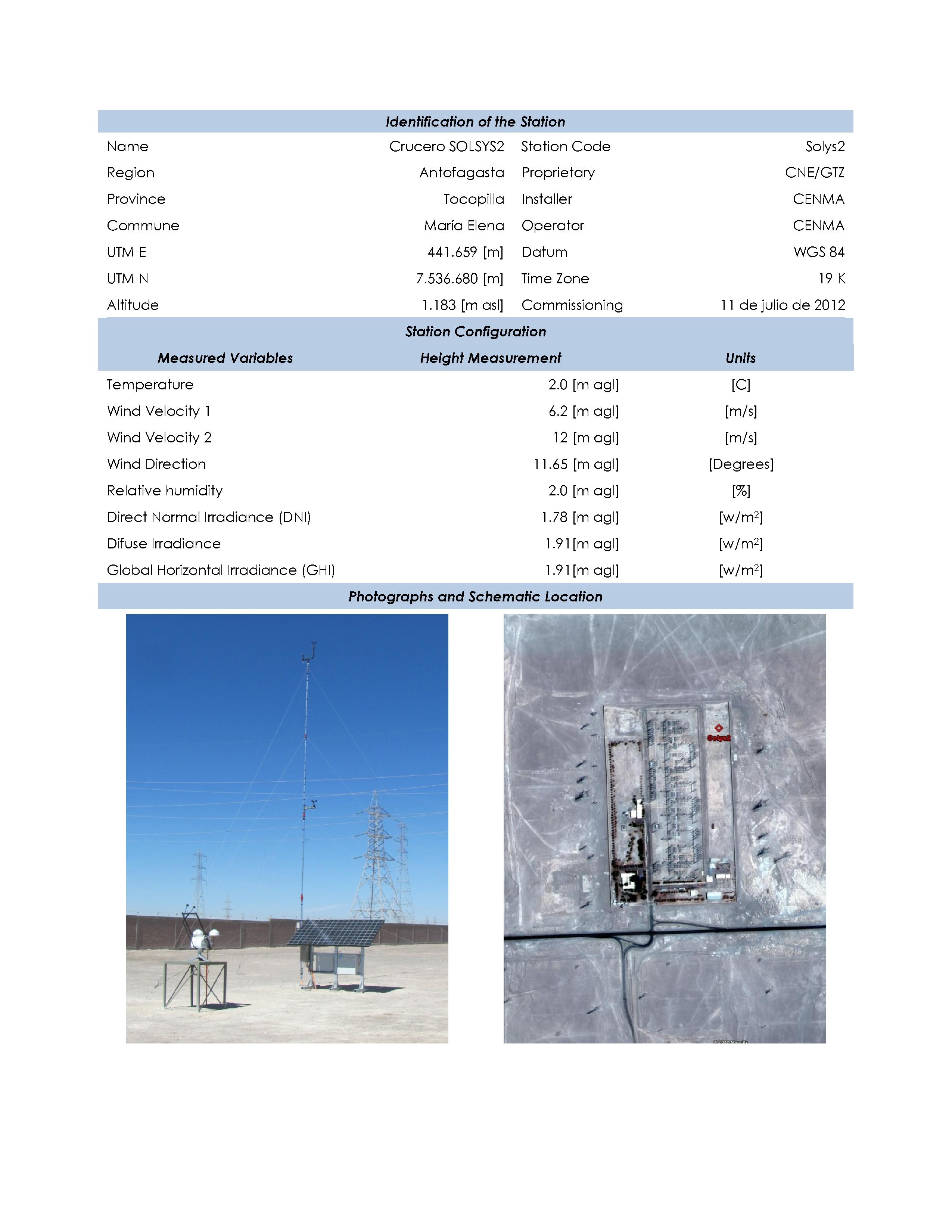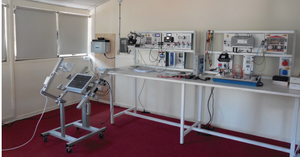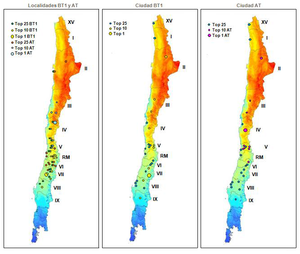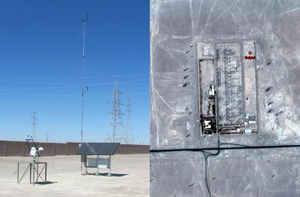Knowledge fuels change - Support energypedia!
For over 10 years, energypedia has been connecting energy experts around the world — helping them share knowledge, learn from each other, and accelerate the global energy transition.
Today, we ask for your support to keep this platform free and accessible to all.
Even a small contribution makes a big difference! If just 10–20% of our 60,000+ monthly visitors donated the equivalent of a cup of coffee — €5 — Energypedia would be fully funded for a whole year.
Is the knowledge you’ve gained through Energypedia this year worth €5 or more?
Your donation keeps the platform running, helps us create new knowledge products, and contributes directly to achieving SDG 7.
Thank you for your support, your donation, big or small, truly matters!
Difference between revisions of "Solar Energy for Electricity and Heat in Chile"
***** (***** | *****) |
***** (***** | *****) |
||
| Line 78: | Line 78: | ||
<br/> | <br/> | ||
| + | |||
| Line 128: | Line 129: | ||
'''Solar measurements''' | '''Solar measurements''' | ||
| − | The project continued the measurement campaign initiated in 2008 to determine the solar potential in northern Chile and made DNI measurements (Direct Normal Irradiation) in the Station "Crucero II" using measuring instruments of high precision. | + | The project continued the measurement campaign initiated in 2008 to determine the solar potential in northern Chile and made DNI measurements (Direct Normal Irradiation) in the Station "Crucero II" using measuring instruments of high precision. [[File:Technical_information_for_the_station_Crucero_II.pdf|Station Crucero II, 2008]] (English) |
<div>[[File:Solar Station in Chile Crucero II.png|thumb|center|300px|Fig: Solar Station in Chile: Crucero II|alt=Solar Station in Chile Crucero II.png]]<br/></div> | <div>[[File:Solar Station in Chile Crucero II.png|thumb|center|300px|Fig: Solar Station in Chile: Crucero II|alt=Solar Station in Chile Crucero II.png]]<br/></div> | ||
[[Solar Energy for Electricity and Heat in Chile#toc|►Go to Top]]<br/> | [[Solar Energy for Electricity and Heat in Chile#toc|►Go to Top]]<br/> | ||
Revision as of 19:00, 29 September 2015
Overview
|
Project |
Solar energy for electricity and heat |
|
Commissioned by |
German Federal Ministry for the Environment, Nature Conservation, Building and Nuclear Safety (BMUB) |
|
Country |
Chile |
|
Lead executing agency |
Ministerio de Energía (Ministry of Energy) |
|
Overall term |
2012 – 2016 |
Context
Chile is enjoying a strong economic growth and the power consumption has doubled every 10 years. Construction of additional conventional thermal power plants and increasing consumption of fossil fuels such as coal are resulting in an increase in greenhouse gas (GHG) emissions. With Chile’s accession to the Organisation for Economic Co-operation and Development (OECD), the country made a commitment to mitigating climate change and announced ambitious GHG reduction goals. The objective of Chile's energy policy is to ensure security of supply at competitive costs considering climate protection criteria. In this endeavor, renewable energy resources are becoming more and more important. In 2008, the quota law for renewables established a basis for their integration into the market. Due to their optimal solar irradiation conditions, Chile has one of the highest solar potentials worldwide. Now, the Chilean Government additionally wishes to promote the use of solar energy.
In order to encourage market development, the Ministry of Energy has implemented the following measures:
- Tax incentives for the use of solar thermal water-heating (solar thermal energy)
- The Net-Billing law for feeding in self-generated electricity from systems delivering up to 100 kW
A start has been made in setting up large scale solar power plants in the north of the country, and the electricity generated through solar energy is competitive compared to the conventional energy generation. Nevertheless, various obstacles, especially for small size installations, have prevented a wider use of solar energy. There are only a few suppliers of PV systems for captive use, and there is also a shortage of qualified specialists. Consequently, the prices for solar installation are still at a high level in comparison with the international market, and the technologies used are not attractive for financial institutions. Banks are cautious when it comes to financing small sized projects and self-consumption system, and there are gaps in the regulatory framework.
Approach
The project “Solar energy for the production of electricity and heat” from the Deutsche Gesellschaft für Internationale Zusammenarbeit (GIZ) GmbH, supports the Chilean government under the framework of the International Initiative for Climate Protection (IKI), in achieving their goals of reducing Green House Gases (GHG), opening profitable market segments for the use of solar energy.
The first stage involved an improvement of the framework conditions for the installation of such a technology. Innovative business models are being developed for each sector, and installers are being trained in order to strengthen local skills and thus, foster new markets for the use of climate-friendly solar energy technology. The work of the project is located at the intersection between the solar market and energy policy.
Market opportunities for self-supply solutions
The project allows the identification of economic sectors and scopes of application in which the captive use of solar power and solar heat for self-supply is economically viable. The insights gained within the scope of project activities are continually factored into the policy advice for use in developing an enabling environment, and are intensified by means of fact-finding tours, workshops and the exchange of information and experience in a national and international level between solar sector actors.
Activities Implemented
Solar laboratories for technical training
The project has set up solar laboratories at six vocational training institutions and universities in the country intending to promote sufficient well-trained installers.
Identification of “Zona de Foco” highly profitable for the photovoltaic self-consumption
The geographic areas with the most cost-effective conditions for the captive-use of PV installations were identified, taking into account the solar irradiation and the electricity tariff as main variables for the profitability. Zona de Foco, 2014
Profitability and feasibility analysis
Technical and economic feasibility studies have been produced for different size captive-use PV applications such as agriculture, viticulture, industry and the public sector.
Price Index of photovoltaic systems
Together with the Association of the Photovoltaic Industry in Chile (ACESOL), a price index of the system costs for PV installations ranging from 1 kilowatt to 1 megawatt in capacity has been created and is updated every six months, comparing the costs with those of Germany as a mature market. This index record changes in costs of PV systems in Chile in the short and medium term.
Support to the Ministry for the completion of the regulatory framework and dissemination of the law for distributed generation (Net-billing / Metering)
The Project participated in the completion of the regulations and technical standards for the distributed generation law. Furthermore, it yielded valuable impetus in the diffusion through a video and a website explaining the operation and administrative processes for connecting an electrical generator under the distributed generation law.
Cadaster of PV rooftops in Calama
The firs solar roof register in Latin America with a calculator for working out the cost-efficiency of PV and ST installations and storage batteries was developed and published for the city of Calama. Solar Cadaster Calama, 2011
Support to the Ministry of Energy in the Public Solar Roofs Programme: “Programa Techos Solares Públicos”
Additionally, they project has been supporting the outreach program, both in its creation and implementation, to introduce photovoltaic plants on public property and so in the maturation of the national PV market. The Ministry of Energy in conjunction with the GIZ is developing guides and manuals on best practices in maintenance and installation of photovoltaic systems for the year 2015, thus promoting the use of solar thermal and photovoltaic energy throughout the country.
ESCO guide for PV self-supply
The objective of the guide is to analyze ESCO and define a business model that allows an Energy Service Company (ESCO) to install and operate a photovoltaic plant and supply the power generated to their customer.
Solar measurements
The project continued the measurement campaign initiated in 2008 to determine the solar potential in northern Chile and made DNI measurements (Direct Normal Irradiation) in the Station "Crucero II" using measuring instruments of high precision.  (English)
(English)
Expected Impacts
The use of solar energy can partly replace electricity generation in conventional power plants, which contributes to achieving the goals of reducing emissions and energy dependence in Chile. A more sustainable and secure energy mix contributes to improving the international competitiveness of the Chilean economy.
Further Information
























